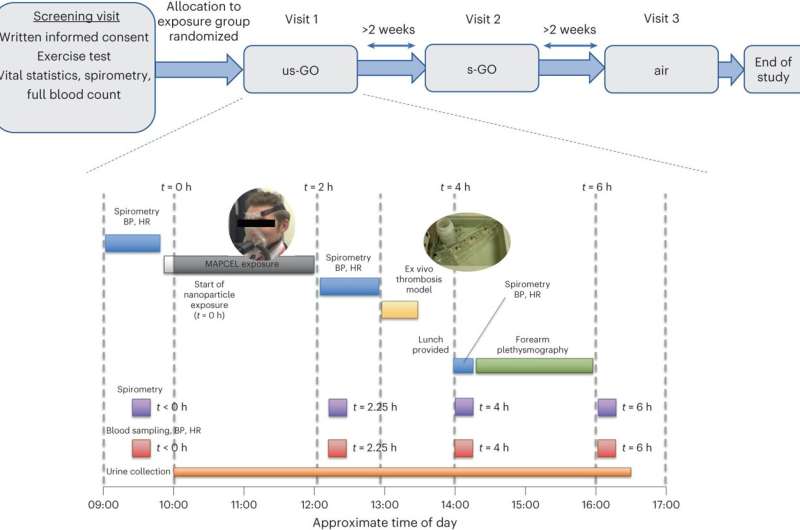This article has been reviewed according to Science X's editorial process and policies. Editors have highlighted the following attributes while ensuring the content's credibility:
fact-checked
peer-reviewed publication
trusted source
proofread
Trial shows safety of controlled graphene inhalation

A revolutionary nanomaterial with huge potential to tackle multiple global challenges could be developed further without acute risk to human health, research suggests. The study is published in the journal Nature Nanotechnology.
Carefully controlled inhalation of a specific type of graphene—the world's thinnest, super strong and super flexible material—has no short-term adverse effects on lung or cardiovascular function, the study shows.
The first controlled exposure clinical trial in people was carried out using thin, ultra-pure graphene oxide—a water-compatible form of the material.
Researchers say further work is needed to find out whether higher doses of this graphene oxide material or other forms of graphene would have a different effect.
The team is also keen to establish whether longer exposure to the material, which is thousands of times thinner than a human hair, would carry additional health risks.
Targeted therapeutics
There has been a surge of interest in developing graphene—a material first isolated by scientists in 2004 and which has been hailed as a "wonder" material. Possible applications include electronics, phone screens, clothing, paints and water purification.
Graphene is actively being explored around the world to assist with targeted therapeutics against cancer and other health conditions, and also in the form of implantable devices and sensors. Before medical use, however, all nanomaterials need to be tested for any potential adverse effects.
Controlled exposure
Researchers from the Universities of Edinburgh and Manchester recruited 14 volunteers to take part in the study under carefully controlled exposure and clinical monitoring conditions.
The volunteers breathed the material through a face mask for two hours while cycling in a purpose-designed mobile exposure chamber brought to Edinburgh from the National Public Health Institute in the Netherlands.
Effects on lung function, blood pressure, blood clotting and inflammation in the blood were measured—before the exposure and at two-hour intervals. A few weeks later, the volunteers were asked to return to the clinic for repeated controlled exposures to a different size of graphene oxide, or clean air for comparison.
There were no adverse effects on lung function, blood pressure or the majority of other biological parameters looked at.
Researchers noticed a slight suggestion that inhalation of the material may influence the way the blood clots, but they stress this effect was very small.
"Nanomaterials such as graphene hold such great promise, but we must ensure they are manufactured in a way that is safe before they can be used more widely in our lives. Being able to explore the safety of this unique material in human volunteers is a huge step forward in our understanding of how graphene could affect the body. With careful design we can safely make the most of nanotechnology," says Dr. Mark Miller.
"This is the first-ever controlled study involving healthy people to demonstrate that very pure forms of graphene oxide—of a specific size distribution and surface character—can be further developed in a way that would minimize the risk to human health.
"It has taken us more than 10 years to develop the knowledge to carry out this research, from a materials and biological science point of view, but also from the clinical capacity to carry out such controlled studies safely by assembling some of the world's leading experts in this field," says Professor Kostas Kostarelos.
More information: Jack P. M. Andrews et al, First-in-human controlled inhalation of thin graphene oxide nanosheets to study acute cardiorespiratory responses, Nature Nanotechnology (2024). DOI: 10.1038/s41565-023-01572-3

















